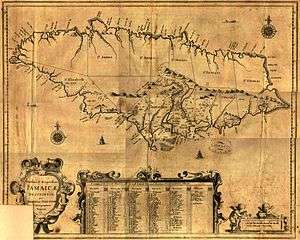Invasion of Jamaica
| Invasion of Jamaica | |||||||||
|---|---|---|---|---|---|---|---|---|---|
| Part of the Anglo-Spanish War (1654–60) | |||||||||
 17th century map of Jamaica | |||||||||
| |||||||||
| Belligerents | |||||||||
|
|
| ||||||||
| Commanders and leaders | |||||||||
|
|
| ||||||||
| Strength | |||||||||
| 1,500 settlers[1] |
7,000 troops 30 ships[2] | ||||||||
The Invasion of Jamaica was an amphibious expedition conducted by the English in the Caribbean in 1655 that resulted in the capture of the island from Spain. Jamaica's capture was the casus belli that resulted in actual war between England and Spain in 1655.[3]
Background
After their defeat at Santo Domingo, the English expedition under Robert Venables and William Penn, fearing to face Oliver Cromwell with only failure decided to attempt to capture Jamaica. The island had little defences and the Spanish settlers by this time numbered just over 1,500 men and women and children. Penn the naval commander, not trusting the army commanders after Santo Domingo took overall command.
Invasion
On Wednesday morning, being the 9th of May, we saw Jamaica Iand, very high land afar off. Wednesday the 10th our souldiers in numbers 7000 (the sea regiment being none of them) landed at the 3 forts...[4]— From the letter of a soldier involved in England's 1655 invasion of Jamaica
On 19 May two Spanish settlers saw a huge fleet just as it rounded Point Morant and warned the Spanish Governor Juan Ramírez de Arellano. The islanders and the governor were caught completely off guard and had to man what fortifications they could. At dawn on 21 May the English penetrated the shallows of Caguaya Bay (now Cagway Bay) William Penn transferred from his 60 gun ship Swiftsure aboard a lighter 12 gun galley Martin and led a flotilla of smaller craft. The smaller craft were used because larger ships would easily have been grounded as the bay was exceptionally shallow and as result some of the flotilla grounded a few times including the Martin before moving on. Soon an exchange of shots began between the English and a battery covering the inner anchorage. This was soon abandoned by its handful of inexperienced defenders that were led by Francisco de Proenza who was a local estate owner, or hacendado.
Penn then disembarked his contingent and advanced six miles to Santiago de la Vega which he easily overran. Penn then swiftly occupied the town and obliged the defeated Ramirez to a request a parlay. Venables, despite being sick, came ashore on 25 May to dictate terms. He announced to Ramírez that the island was to be permanently annexed by the Commonwealth of England and that the inhabitants are to abandon the island within a fortnight, on pain of death. Ramírez temporized for two days but eventually signed the arrangement on 27 May; shortly thereafter he sailed for Campeche, dying en route.
Not all the Spanish residents recognized this arrangement however, and Maestre de Campo de Proenza after evacuating many noncombatants by boat toward Cuba from northern Jamaica established his headquarters at the inland town of Guatibacoa, allying himself with the maroons of the mountainous interior to inaugurate a guerrilla war against English occupation.
Aftermath

The English were soon falling sick and starving and Penn and Veneables would take most of the expedition back to England in August. Justifying Penn's and Venables fears for not capturing Hispaniola, Cromwell threw them both in the Tower.[5] The remaining English suffered severely from disease and want of provisions, dying by the hundreds. Within a year the 7,000 English officers and troops that took part in the invasion were reduced to 2,500. Sickness however soon swept through the Spanish and one of the first victims was the unfortunate de Proenza who was left blind. He was succeeded by Cristóbal Arnaldo de Issasi, who continued a rather ineffectual resistance for three more years.
The Spanish attempted to retake Jamaica twice over the next few years; the first was when Issasi was defeated at Ocho Rios in 1657 and with a much larger force recruited from New Spain was defeated again at Rio Nuevo in 1658. After these failures Jamaica along with the Cayman islands was eventually ceded by the Spanish to the English crown at the Treaty of Madrid (1670).
Under British rule Jamaica soon became a hugely profitable possession, producing large quantities of sugar for the home market and eventually for other colonies.
References
- Bibliography
- Black, Clinton, The story of Jamaica from prehistory to the present. Collins, London 1965.
- Hart, Francis Russel. Admirals of the Caribbean, Boston, 1922.
- Marly, David Wars of the Americas: A Chronology of Armed Conflict in the New World, 1492-1997 ABC-CLIO Ltd 1998 ISBN 0-87436-837-5
- Rodger, N. A. M.. The Command of the Ocean, New York, 2005. ISBN 0-393-06050-0
